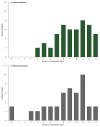State-Level Trends and Correlates for Cross-Sector Collaboration on School Nutrition and Physical Education Activities, 2000-2012
- PMID: 27442994
- PMCID: PMC4970618
- DOI: 10.5888/pcd13.160032
State-Level Trends and Correlates for Cross-Sector Collaboration on School Nutrition and Physical Education Activities, 2000-2012
Abstract
Introduction: Cross-sector collaboration on child obesity prevention is common, yet little research has examined the context of collaboration at the state level. This study describes secular trends in collaboration between state agency staff responsible for school nutrition and physical education activities and other organizations from 2000 to 2012.
Methods: Data from the School Health Policies and Practices Study were used to describe collaboration between state agency staff and 13 types of public, private, and nonprofit organizations. Breadth of collaboration in 2012 was examined across political, social, and economic conditions.
Results: Collaboration between state agency staff and other organization types increased from 2000 to 2006 and decreased or stabilized from 2006 to 2012. Breadth of collaboration was greater in states with a physical education coordinator, higher levels of poverty, higher prevalence of childhood obesity, and more public health funding. Breadth was similar across states by census region, political party of governor, majority party in state legislature, percentage non-Hispanic white population, high school graduation rate, and unemployment rate.
Conclusion: Cross-sector collaboration on school nutrition and physical education was widespread and did not vary substantially across most political, social, and economic measures. Expanded monitoring and surveillance of state-level collaboration would assist efforts to understand how state agencies work across sectors and whether this collaboration affects the support they provide to schools.
Figures
Similar articles
-
Evidence-based policies on school nutrition and physical education: Associations with state-level collaboration, obesity, and socio-economic indicators.Prev Med. 2017 Jun;99:87-93. doi: 10.1016/j.ypmed.2017.02.005. Epub 2017 Feb 13. Prev Med. 2017. PMID: 28209518 Free PMC article.
-
Support for school-based obesity prevention efforts: attitudes among administrators at nationally representative samples of US elementary schools.Child Obes. 2013 Aug;9(4):311-8. doi: 10.1089/chi.2013.0029. Epub 2013 Jun 15. Child Obes. 2013. PMID: 23767807
-
State Agency Support of Weight-Related School Policy Implementation.J Sch Health. 2018 Sep;88(9):685-692. doi: 10.1111/josh.12673. J Sch Health. 2018. PMID: 30133777
-
Reading, writing, and obesity: America's failing grade in school nutrition and physical education.Nutr Clin Pract. 2011 Oct;26(5):553-64. doi: 10.1177/0884533611416820. Nutr Clin Pract. 2011. PMID: 21947638 Review.
-
Integrating nutrition into the education sector in low- and middle-income countries: A framework for a win-win collaboration.Matern Child Nutr. 2021 Jul;17(3):e13156. doi: 10.1111/mcn.13156. Epub 2021 Feb 16. Matern Child Nutr. 2021. PMID: 33590645 Free PMC article. Review.
Cited by
-
Evidence-based policies on school nutrition and physical education: Associations with state-level collaboration, obesity, and socio-economic indicators.Prev Med. 2017 Jun;99:87-93. doi: 10.1016/j.ypmed.2017.02.005. Epub 2017 Feb 13. Prev Med. 2017. PMID: 28209518 Free PMC article.
-
The effect of comprehensive intervention for childhood obesity on dietary diversity among younger children: Evidence from a school-based randomized controlled trial in China.PLoS One. 2020 Jul 17;15(7):e0235951. doi: 10.1371/journal.pone.0235951. eCollection 2020. PLoS One. 2020. PMID: 32678852 Free PMC article. Clinical Trial.
References
-
- Institute of Medicine. Cross-sector response to obesity: models for change. Workshop summary. Washington (DC): The National Academies Press; 2015. - PubMed
-
- Institute of Medicine. Building public-private partnerships in food and nutrition: workshop summary. Washington (DC): The National Academies Press; 2012. - PubMed
Publication types
MeSH terms
Grants and funding
LinkOut - more resources
Full Text Sources
Other Literature Sources
Medical


